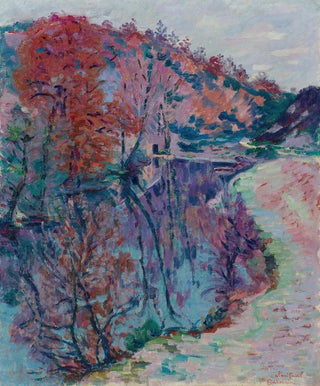Art print | Bords de la Sedelle Crozant - Armand Guillaumin


View from behind

Frame (optional)
In the vast panorama of Impressionism, the artwork "Bords de la Sedelle Crozant" by Armand Guillaumin stands out for its vibrant light and bold palette. This painting, which captures the very essence of nature, invites the viewer on a contemplative walk along the riverbank. The reflections of the sky in the water and the lushness of the surrounding landscapes evoke an atmosphere of serenity and wonder. Guillaumin, with his unique approach, manages to translate the fleeting beauty of the natural world into a timeless work that still resonates today. The art print of this masterpiece offers a window into the artistic universe of the period, allowing everyone to feel the magic of light and colors.
Style and uniqueness of the work
Armand Guillaumin's style is characterized by a daring use of colors and a keen sense of light. In "Bords de la Sedelle Crozant," the brushstrokes are both swift and precise, creating a dynamic texture that brings the scene to life. The shades of green and blue blend harmoniously, while the touches of light evoke the warmth of a sunny afternoon. The composition, though simple, is of great depth, each element of the painting carefully arranged to guide the eye through the landscape. This piece does not merely depict a place; it captures its soul, offering an immersive visual experience that transports the viewer to the heart of nature. The singularity of this work lies in its ability to evoke emotions and stimulate the imagination, testament to Guillaumin's artistic genius.
The artist and his influence
Armand Guillaumin, a prominent member of the Impressionist movement, made his mark on his era with his innovative approach to painting. Born in 1841, he was influenced by artists such as Claude Monet and Camille Pissarro, but developed a style that is uniquely his own, focusing on the expression of lights and atmospheres. His passion for nature and his desire to capture the present moment are palpable in each of his works. Guillaumin also played a crucial role in the recognition

Matte finish

View from behind

Frame (optional)
In the vast panorama of Impressionism, the artwork "Bords de la Sedelle Crozant" by Armand Guillaumin stands out for its vibrant light and bold palette. This painting, which captures the very essence of nature, invites the viewer on a contemplative walk along the riverbank. The reflections of the sky in the water and the lushness of the surrounding landscapes evoke an atmosphere of serenity and wonder. Guillaumin, with his unique approach, manages to translate the fleeting beauty of the natural world into a timeless work that still resonates today. The art print of this masterpiece offers a window into the artistic universe of the period, allowing everyone to feel the magic of light and colors.
Style and uniqueness of the work
Armand Guillaumin's style is characterized by a daring use of colors and a keen sense of light. In "Bords de la Sedelle Crozant," the brushstrokes are both swift and precise, creating a dynamic texture that brings the scene to life. The shades of green and blue blend harmoniously, while the touches of light evoke the warmth of a sunny afternoon. The composition, though simple, is of great depth, each element of the painting carefully arranged to guide the eye through the landscape. This piece does not merely depict a place; it captures its soul, offering an immersive visual experience that transports the viewer to the heart of nature. The singularity of this work lies in its ability to evoke emotions and stimulate the imagination, testament to Guillaumin's artistic genius.
The artist and his influence
Armand Guillaumin, a prominent member of the Impressionist movement, made his mark on his era with his innovative approach to painting. Born in 1841, he was influenced by artists such as Claude Monet and Camille Pissarro, but developed a style that is uniquely his own, focusing on the expression of lights and atmospheres. His passion for nature and his desire to capture the present moment are palpable in each of his works. Guillaumin also played a crucial role in the recognition






